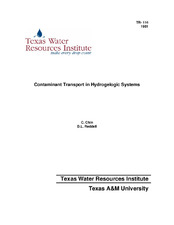| dc.description.abstract | Contaminant transport in hydrogeologic systems requires knowledge of transmissivity, storage coefficient, and dispersivity. Techniques for evaluating transmissivity and storage coefficient under field conditions are well known. However, the evaluation of dispersivity under field conditions is a costly and time consuming job.
The process of transporting a specific conservative ion species in an aquifer is analogous to the transport of heat in the system. Because of this analogy, the original objective of this research project was to evaluate the use of low-grade thermal water to measure aquifer dispersivity. However, available thermal models of groundwater aquifers proved difficult to use for evaluating the thermal properties (and dispersivity) of an aquifer. Therefore, additional objectives were developed to (1) derive analytical solutions describing the steady and unsteady temperature distribution around a well with a finite caprock thickness and (2) establish a technique for determining the thermal properties (including thermal dispersivity) of an aquifer using field measurements of temperature distribution within the aquifer.
Analytical models of hot water injection into groundwater aquifers were developed in this study. Available analytical models of this problem assume that the caprock overlying the aquifer is of infinite thickness. However, many groundwater aquifers have caprock thicknesses of only a few meters. This paper shows two mathematical models which were developed to examine the influence of a caprock with finite thickness on the thermal response of an aquifer. In both models, the horizontal heat conduction and heat convection in the aquifer plus the vertical heat conduction in the caprock are considered. The first model (Model I) assumed that the vertical temperature gradient in the caprock is linear, which can be approached in a caprock with a relatively small thickness. The second model (Model II) removed this restriction and allowed the vertical temperature gradient in the caprock to be nonlinear. For Model I, a steady state and an unsteady state solution for the water temperature distribution surrounding an injection well were obtained. For Model II, a steady state and two unsteady state solutions for the water temperature distribution surrounding an injection well were obtained. One of the two unsteady state solutions is for a short-time period and the other one is for a long-time period.
A graphical technique was developed for determining four pertinent aquifer thermal properties: (1) the horizontal thermal conductivity of the aquifer (thermal dispersivity), (2) the thermal capacity of the aquifer, (3) the vertical thermal conductivity of the caprock, and (4) the thermal capacity of the caprock. Dimensionless type curves are constructed from the steady state solution and the unsteady state solution for short time periods in Model II, respectively. Using field data, one curve is constructed using long-term temperature observations (approaching steady state) from several observation wells, and a second curve is constructed using short-time temperature observations from any one of the observation wells. These curves are then matched with the dimensionless type curves, respectively, and values of the four aquifer thermal properties evaluated.
Since the steady state condition is difficult to attain in the field, an approximate graphical technique for evaluating the thermal parameters is developed without using the steady state field date. In this approximate method, the vertical thermal conductivity of the caprock is assumed equal to the horizontal thermal conductivity of the aquifer, and the thermal capacity of the caprock is assumed equal to the thermal capacity of the aquifer. | en |


